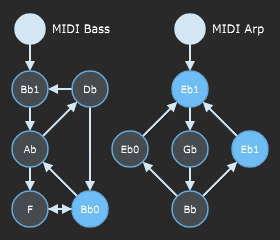
Developer Sebastian Arnold today introduced Senode – a new node-based graphic music sequencer.
The basic idea of Senode is to draw your entire composition as a cyclic graph of nodes and edges. Each node can generate events, such as notes, chords, effects, or any other MIDI or OSC message.
You can now use any incoming signal or a clock to change the current position of ‘tokens’ around the graph.
There are many interaction options that let you decide the generation, direction, transformation and synchronization of the tokens. At all times, your graphical score is perfectly readable. This makes this sequencer the perfect tool for interactive performance of pre-written and generative music.
Here’s a demo:
“I use Senode as the only sequencer in my live setup,” notes Arnold. “All songs are patched inside the program and are controlled via MIDI.”
“I use the G2 Modular to generate clock signals and include signals from my drums to trigger important events on the graph. Senode generates MIDI messages for the Nord Modular G2 and Nord Lead 4R synthesizers and the Pianoteq VST sampler.”
Here’s a high-level diagram of a sample use case for Senode:

Senode releases are planned for for Windows, OSX and Linux. A beta will be available soon. See the Senode site for more info.

neat graphic, and idea
This has some interesting potential. If these strands of notes, chord, or other events are able to be influenced by probability, as well as other strands, it could be quite deep.
For example, if there was a strand that had a chord progression with probabilities, and then which ever chord was active would cause a switch to a different strand of single notes, the you could have melody and chords that stay linked.
It’s been done: http://www.csse.monash.edu.au/~cema/nodal/
Yeah, I’ve seen Nodal as well. It has a similar approach (graphs, basically), but the whole idea of traversing the graph is different. Nodal feels more generative and non-deterministic. Senode is more about control. In Senode, the player is able to manage the synchronization and direction of tokens. You can step through the graph manually (like the bass drum pattern in the video) and decide the active edges depending on the currently active scene. Additionally, nodes can trigger chords, map to different channels for different instrument instances, and they can transpose or inherit velocity of incoming notes notes. Both programs are strong in their own rights, and there are even more cool graph music examples, such as Iannix or Machina.
Hi Sebastian, thanks for your reply. Sorry if I sounded snippy. How about an IOS version of Senode?
Hi Dave, the very first version will be Win/OSX/Linux standalone. But after all the positive feedback I get these days, I will focus on iOS after the first release. Best, Sebastian
iOS would be really cool. How can we trigger the note Changes? Does it work with midi too?
IOS NEEDS this , it would be a lovely addition with a touch screen for altering the chance of each node, turning nodes on and off etc….great idea.
german engineering skills meet german composition skills. what could easily go wrong? 😉
great new approach to music and notation. lots of potential. but make it iOS, too, bitteschön!
Sure looks an awful lot like Nodal Generative Music software. http://www.csse.monash.edu.au/~cema/nodal/
A nice idea that is done well. I find it inspiring, I have been looking for a idea to build something predictive in max for live, this seems the ticket – I am calling it a homage 😉
IPad app, please!
Bravo! Senode looks like a nice use of Hamiltonian Circuits as a compositional paradigm. I definitely plan on buying this when it comes out.
People keep comparing Senode to Nodal but there are significant differences between the two programs. In any case, each of these types of instantiations has its own advantages and drawbacks, so it’s a great idea to have multiple different instantiations of the Hamilton Circuit directed graph approach to composition.
The exciting aspect of a program like Senode that it may be open-ended enough to qualify as a state-space machine. As we all know, a true state-space system is Turing Complete — there are no limits on the things it can compute. That bodes well for a sequencer based on the state-space paradigm.
Cyclic Note Generation? “New”?
*cough* Audio Damage’s AXON *cough*
http://www.audiodamage.com/instruments/product.php?pid=AD026